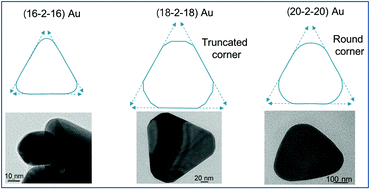Eicosyl ammoniums elicited thermal reduction alleyway towards gold nanoparticles and their chemo-sensor aptitude†
Abstract
The construction of dimethylenebis(eicosyldimethylammonium bromide) surfactant-directed gold nanoparticles (NPs) has been accomplished via a one-pot thermal reduction of HAuCl4 with trisodium citrate. The effect of cationic twin-tail surfactants, dimethylenebis(hexadecyldimethylammonium bromide) (16-2-16), dimethylenebis(octadecyldimethylammonium bromide) (18-2-18) and dimethylenebis(eicosyldimethylammonium bromide) (20-2-20), and their concentrations on shape and size of Au nanoparticles was thoroughly investigated. The UV-Vis spectroscopy and transmission electron microscopy (TEM) results show that longer tail length surfactants act as shape-directing agents promoting diversified morphologies. The formation of multiple-shaped Au nanoparticles, such as round, hexagonal, pentagonal, triangular and rod-like, has been confirmed from microstructure analysis; among them, many triangular shapes enhanced at elevated levels of surfactant concentration. In addition, the triangular Au nanoparticles with truncated corners were changed to smooth corners as the hydrocarbon chain length increased from (18-2-18) to (20-2-20). The concentration and hydrocarbon tails of twin-tail surfactants strongly influence the size and structure of Au NPs. In addition, the Au NPs synthesized with the twin-tail surfactant (18-2-18) were found to be highly sensitive towards Hg2+, which could be because of the preferential adsorption of Hg0 on the lower energy facets of triangular-shaped Au NPs.



 Please wait while we load your content...
Please wait while we load your content...